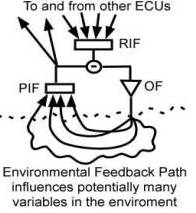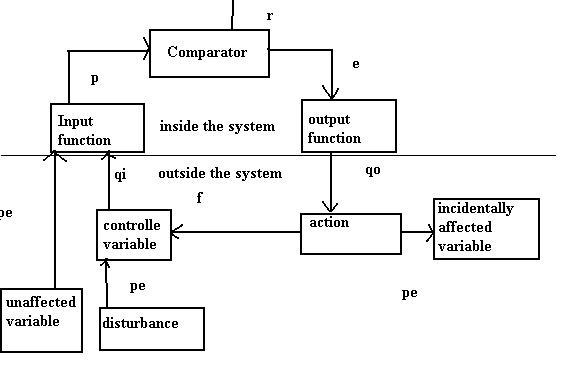[From Bjorn Simonsen
(2005.09.07,15:28 EST)]
Marin Taylor 2005.09.06.10.10
This thread may have gone a wrong way because of bad linguistics from
my part. I will try to do it better here, but I am afraid it will be many
words.
Yes I did use Richard’s definition for conflict and I still think it is
good enough. In this mail I have also used your figures, Martin and a quotation
from Bill.
Basis
Conflict occurs when two control systems try to bring the same (or a
similar) >>perceptual variable to different reference levels. When the
two control systems are in >>two different people we have an
interpersonal conflict; when the two control systems >>are in the same
person we have an intra personal conflict.
That’s not a precise definition, and the imprecision may be causing
your question. More precisely (but not definitively!), conflict occurs
when two control systems in controlling their perceptions use the
same external variable(s) in their feedback path in such a way that it
is not possible for both controlled perceptions to attain their reference
values at the same time.
I appreciate precise definitions. Thank you.
But let me dwell on your last sentence.
Remember, when you wrote the sentence; you controlled your perceptions.
When I read the sentence I control my perceptions. Let us say you sit beside me and we both read your sentence at
the same time.
We have different references. The sentence is the disturbance. The
disturbance is the same (I hope). Let us assume the physical effect from the sentence is the same for both of
us. Let us assume there is no feedback variable (just when we start looking at
the sentence). Then the input quantity, qi (s on your figure (I prefer qi))
should be about the same for
both you and me.
I am quite sure that the constants in your input function are different
from mine. But let us assume that they are the same. Then p = kiqi (your
figure p = kis). Now p is the same in you and in me.
The reference signals are different. The error becomes different. I get
an error and your error is zero. You relax and love the world.
My error results in an output signal and actions. I put your sentence
away and start controlling another perception, -writing this mail. Periodical I
read your sentence again and I get my error.
I guess you get your error when you read this.

This was an experiment being funny. Back to real work.
your question. More precisely (but not definitively!), conflict
occurs
when two control systems in controlling their perceptions use the
same external variable(s) in their feedback path in such a way that it
is not possible for both controlled perceptions to attain their reference
values at the same time.
You say “when two control systems use the same external variable in
their feedback path in such a way that ….”
I think it is wrong to say that the control systems use …. (of course this may be a linguistic
misunderstanding).
Let me explain why I think it is wrong. Perceptions (perceptual
signals) are often created by the effect of physical effect from the
environment (your sentence). Copies of perceptual signals (a huge quantity of
them) pass to higher levels. When they meet reference signals less than the
perceptual signal, no signals continue because errors can’t be negative.
When perceptual signals meet reference signals with a greater value,
errors are formed. Output signals become reference signals at lower levels.
Some of these reference signals meet perceptual signals with a greater value
than the reference signal and the signals die out. Errors can’t be negative.
The signals that continue form a control system and the output signals
at the lowest levels induce actions that may influence the disturbances. This
continues until the disturbances stimulates to a perceptual signal like the
reference signal at the level where perceptions are controlled.
Please concentrate now, and look at your sentence above. The control
systems are not able to “use or not use” external variables in their feedback
path. The feedback variable becomes a value dependent on the body’s actions.
And afterwards the perceptual signals change and so also the feedback signals.
It isn’t sufficient that the two systems use some of the same
external
variables in their feedback paths, because each may have other
external variables that would serve to bring their controlled perceptions
to their reference values. For example, if control system 1 is controlling
P1=A+B+C and control system 2 is controlling P2=A+X+Y, the
fact that they both may attempt to change A in opposite directions may
cause each to disturb the other’s perception, but control system 1 can
resist the disturbance without conflict by altering B and C, while
control system 2 alters X and Y.
Why are you so preoccupied with the same external variables in the
feedback paths? In two different persons I guess they are different even though
the disturbance is the same and the reference value is the same. Different
people have different gains and different slowing factors in their output
functions.
And in my argumentation above, the extern variable in your system was
zero (near zero) and the variables in my feedback system have still great
values because I am still arguing with you.
I read your use of symbols in P1=A+B+C and P2=A+X+Y as P1 = f(A+B+C) and P2=g(A+X+Y). But then I
get a problem when A changes in opposite directions. If so happen, the two
different functions may suspend the effects you name.
I also have problems with B, C, X and Y in your equations. Are one of
them memory? J
Go to the figure above and tell me where I can find them. Do you think
upon the many variables in the environment on your own figure below? I think
your figure is correct, but I can’t understand the effect. The feedback signal
work against the disturbance till the perception is like the reference signal.
The number of feedback signals doesn’t matter objectively in a conflict
situation.
![]()
I control my perceptions as regards “Petersons
shall be invited”.
I also have the experience/reference
that my wife wishes "not
to invite the Petersons". It is my experience/reference.
Is it correct to say that interpersonal conflicts
are intra personal conflicts?
Not
as so far described. The conflict you have described so far is that
both are controlling for perceiving the external variable "Petersons
are
invited", but their reference levels are different, and the
perceptions
cannot both come to their reference levels at the same time.
I am
sorry. I think you misunderstand me. I told a story:
Basis 1
and Basis 2.
My wife and I will invite some friends Saturday night. We
disagree
about inviting the “Petersons”. I will invite the “Petersons” and my
wife will not. We call this an interpersonal conflict.
I have a reference, something like “I wish to invite
Petersons”.
I am not
absolutely sure that my wife has a corresponding
reference like “The Petersons should not be invited”. But I have
tested the perceptions she controls and I have the theory that she
controls the named perceptions.
And this story is in harmony with your comment:
Not
as so far described. The conflict you have described so far is that
both are controlling for perceiving the external variable "Petersons
are
invited", but their reference levels are different, and the
perceptions
cannot both come to their reference levels at the same time.
Then
I expressed my
Problem
I control my perceptions as regards “Petersons shall be
invited”.
I also have the
experience/reference that my wife wishes "not
to invite the Petersons". It is my experience/reference.
Is
it correct to say that interpersonal conflicts are intra personal conflicts?
Let
me be more detailed.
![]()
So because I am not sure if my wife exists, I ask the question: “Is
it correct to say that what normally is called inter personal conflicts are
intra personal conflicts?
You would have an intra
personal conflict if you were also controlling for
a perception of your wife’s satisfaction with the state of the invitation
to the
Petersons, and your reference level for that perception was that she be
happy about it.
I read this as I have an intra
personal conflict because I am sure I wish to allow for my wife’s wish to not
invite the Petersons at the same time I wish to invite the Petersons every time
I invite guests.
I am not sure if there is any inter personal conflict
because I can never be sure about my wife’s existence. Well she exists, but the world I experience is a function of the world that
exists outside me, but is by no means isomorphic to it – that is, we can’t
know whether she (my wife) is or not, and the probabilities are (it seems to
me) that she isn’t. (Bill).
Is it
correct to say that inter personal conflicts are just some theories (thoughts)
we have? Is it correct to say that counter control also is some theories
(thoughts) we have? If I am person A it is just a theory that person B exists.
bjorn



oledata7.mso (36.8 KB)




